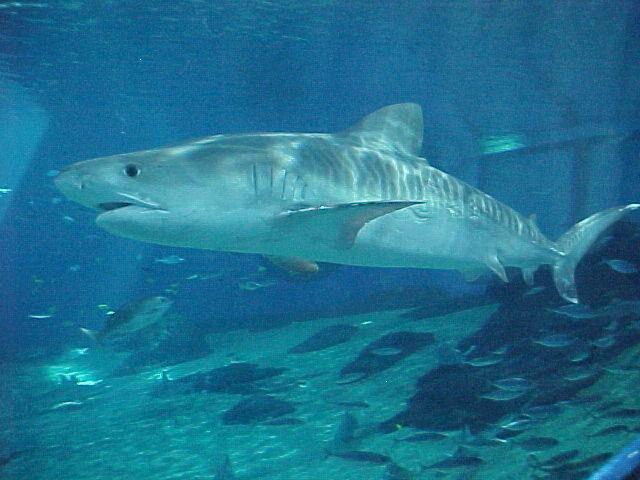The Maui News
April 1, 2001
By JESSICA FERRACANE
Lahaina boat captain Tom Allen doesn't know what landed on him when he was out surfing at Napili Bay a year and a half ago, but he does know that he is very lucky.
Click for bigger Allen had just finished riding a really good wave all the way from the outside break at Little Makaha to the inside cove. It had been raining, and a river of muddy runoff streamed into the bay, making the water so murky he couldn't see his hands. But the 4-foot waves were irresistible to Allen and a few dozen other surfers the morning of Nov. 16, 1999. After he finished his ride, Allen lay on his board and began the long paddle back out.
He had taken about three strokes when something rushed in on him from the right.
"It felt like a pig was writhing around on my back. It sunk the tail of my board. I was scared out of my mind," the 42-year-old surfer recalls.
Three other surfers were near Allen, and the youngest, a boy around 17, started screaming, "Shark! Shark!" Allen remembers the others started to paddle furiously toward shore. Then whatever it was swam off. He never caught a glimpse of the creature.
Whatever "it" was also smashed the right rail of Allen's surfboard and left painful abrasions on his right shoulder Ö a sign of a possible brush against the rough, sandpaperlike skin of a shark.
Thankfully, experiences like Allen's are uncommon. Mano (sharks) are not normally encountered in Hawaiian waters by the average oceangoer. But they're out there, approximately 35 different species, including the infamous niuhi, or tiger shark.
Two confirmed shark attacks occurred in Maui waters last year. In October, a California snorkeler was bitten on her upper and lower back a half-mile off Camp Pecusa. In August, a French windsurfer was bitten on the lower left leg a mile off Kanaha Beach Park. Tiger sharks are suspected in both attacks.
Kahu (pastor) Charles Kauluwehi Maxwell, whose family worshipped mano as aumakua, or ancestral deities, in Maalaea, says his family had certain rules about entering the ocean. These rules and a few others are published as safety tips by the state Department of Land and Natural Resources:
Avoid entering the ocean at dawn and dusk, and never enter the ocean anywhere near murky river mouths. Although sharks have specialized sensory organs that assist them in locating prey, many mano feed at night and could mistake a person for their preferred prey (like fish and turtles) in the dark. The same thinking applies to murky areas, where mano have an advantage in the reduced visibility to find their prey. Sharks tend to swim through our imaginations as stealthy, aggressive predators, a belief fueled in part by the book and movie "Jaws." But the truth is shark attacks on humans are rare in Hawaii, averaging about two a year. And in most cases, the victim survives, perhaps because when sharks do attack humans, it's usually a case of mistaken identity.
Fascination is replacing fear as more is learned about the powerful, mysterious creatures. People want to see sharks, but they are rarely sighted in the reefs and open ocean. In fact, if large (more than 8 feet long) sharks are sighted, the Department of Land and Natural Resources wants to know. The hot line is at (800) 468-4644.
A place guaranteed to be safe to observe mano in Hawaii is the astounding 750,000-gallon open ocean tank at the Maui Ocean Center in Maalaea. Several different Hawaiian mano swim through the massive aquarium, including sandbar sharks, whitetip reef sharks, gray reef sharks and blacktip reef sharks.
An acrylic tube allows visitors to walk through their watery domain without getting wet.
It's easy to lose track of time there while examining sharks from every angle as the creatures swim overhead along with other fish species, including large rays.
The low lighting and soft music make for serene viewing. On some days, Uncle Charlie Maxwell is there, sharing his family stories about their aumakua and about his great-grandmother, who fed mano in Maalaea Bay.
"Ka Mo'olelo Moana," or "Ocean Story," is a monthly column submitted by the Maui Ocean Center, located in Maalaea and open daily from 9 a.m. to 5 p.m. For more information, call 270-7000.
Ho`iho`i Mai
Return
